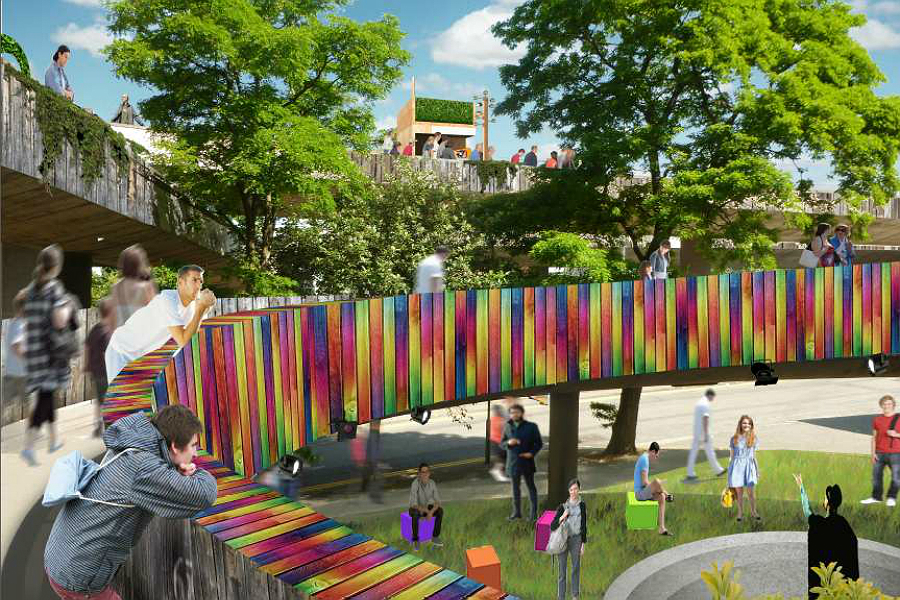Grand Designs — Friends Of The Flyover

Can we really build our own city? Laura Brown talks to Kate Stewart from the Flyover project about why this might be the first step towards urban planning that’s healthy, happy and designed by us, for us…
Starting things on a downer is always, as they say, poor form, but here goes. When all the dust has settled, when all the spinning has stopped, there’s one thing we have to know; we have less money. There is less to spend on all the things we believe as a society we should be spending money on.
Yet even if we’re skint, we can’t give up on the things we believe in, can we? Can we still, for example, build a city and a place to live in that’s happy, healthy and inspiring? Adversity is, we’re told, character building. So what are we going to build?
The Royal Institute of British Architects (RIBA) recently published a City Health Check report (read our interview with the Regional Director Andrew Ruffler here) asking how far cities support healthy and active choices on a daily basis, as well as reflecting on how far architecture and urban design impact on public health. What does this have to do with the public purse and grand designs? Well, as RIBA says, there’s “a clear link between land use and public health in cities”.
Secondly, they add that “people say it is the quality not quantity of streets and parks that will encourage them to walk more”. This directly impacts on how much we spend on public health (now under the control of local authorities). If 75% of people who don’t do enough exercise met the recommended walking quota (150 minutes a week), then £675m could be saved in a year.
This suggests we need to reassess the decisions we’re making about our cities and think about a more holistic view. But whose responsibility is it? The grand civic schemes of the past are, largely, going to stay where they are: behind us. Who’ll create the big builds that aren’t just money spinners, that don’t include the requisite ‘student apartments’ and ‘mixed use developments’? Who’s going to build the things that are good and healthy and that are being built because we SHOULD be building them and because we LIKE them?
And so we witness what The Friends of the Flyover have achieved in a relatively short amount of time. Recently smashing their first crowdfunding target, they plan to turn the Churchill flyover in Liverpool city centre — which was earmarked for removal — into a green pedestrian and cycle-friendly promenade in the sky.
Sitting down for coffee with one of the team of three behind it, Kate Stewart, she lets out a breath and says: “How amazing is it that the city has taken it to its heart?”
The Flyover project is probably something you’ve heard about — it’s had quite a bit of buzz. You might even have donated money. You might feel a sense of ownership because you supported it. But if you did offer your support, did you know you’ve signed up to something much bigger than a novel way of repurposing a public highway? You’re part of a fledgling movement to fundamentally change the way we plan and deliver our cities of the future.
There are three people in the Friends of the Flyover team: Kate Stewart, Steve Threlfall and Mark Bennett. All work in design and architecture and are “really passionate about our city”. On a trip to Rotterdam, the trio became inspired by people who had brought about change and tackled resistance. Later in the evening, over a bottle of wine, they mused that it couldn’t happen here. “These people would say no and those people would say no and there’s all this regulation”.
Then they stopped themselves. “If we do nothing we’re part of that negative process. Why shouldn’t we use our skills and clear enthusiasm to bring about change like they have?”
A little bit tipsy, Kate, Steve and Mark drafted a business plan. OK, many of us develop world-changing ideas after a couple of scoops (a friend and I once wrote down our musings on how the world worked — the following morning there was a lot of scribbling about sheep and Guinness). Few of us get up the next day and are still convinced not only that it will work, but that people will endorse and support it.
The Flyover is just the first step. “We have five projects that we would give to the city and we call them ‘provocations.’ Under the name We Make Liverpool, there’s the flyover project, a hub space in the Baltic Triangle and the business district which culminates in a festival.”
It’s big, headline, idealist stuff that gets the mental juices flowing and truly empowers people.
The friends went to Spacehive, the world’s first crowdfunding website for civic projects, and launched the Flyover campaign 6th January 2014. The rest, as they say, is history. The £40,848 target they reached is for the first phase; a feasibility study that will see designs developed along with consultation with local residents and businesses. They’ve worked alongside the council about how the project can develop and be taken forward. Many of the support given has been in-kind as well as fiscal.
It sounds like there are a lot of us that fancy a change. There is a desire to create a lasting legacy, to shape and build something that represents an aspiration and a desire to make life better. Liverpool is a political and provocative city; it is built on difference and divergence, a need to affect change and make our mark. How we build has to be part of that. Shopping centres and student high rises are great, but they’re not everything.
We don’t want – can’t be – an identikit place where you could be anywhere. Building development often focuses on a high net worth or transient community, not interested in building lives and experience, or in the city itself for any lasting period of time.
“It’s interesting,” muses Kate. “We have all this green space in the city but at the same time we’re increasing the density and the residents in the city centre and these people don’t have any green space, and it’s really vitally important. One of the comments we got was from someone who works in Chester but lives in the city centre. They think the Flyover is something that will improve their livability. We’ve had emails from people in their seventies who like to walk but don’t feel safe taking their dog off a leash.”
When you have time, read the Strategic Investment Framework for Liverpool. It creates an ‘Arc of Opportunity’; basically big, grandiose schemes that will change how we move around the city, how we’ll interact with it and enjoy it as well as how we’ll make our big impression to visitors. The Flyover is actually in an earlier incarnation of this, the SIF from 2012, when the St George’s project — an ambitious proposal to make St George’s something more akin to Trafalgar Square and to re-route traffic — was discussed. There are plenty of people, from Liverpool Vision right down to the fella at the end of the bar at the Caledonia, who have big dreams and ideas about how they want Liverpool to be a happy, healthy, inspiring and world-changing place.
And yet… We all need to have a say. Or feel like we’re empowered enough to have a say. Things are, ultimately, in a state of flux. How much money we have, how things are funded, why they are funded; all these things are changing. So why stop there? Why not take this as an opportunity to give ordinary people a real opportunity to change the city around us? Why not ask people about what they want their neighbourhood to look like at some point before it ends up on page 6 of the Echo?
We can all define what we want Liverpool to be. In the long run, if we additionally create a healthier city, we’ll not only feel better, but we’ll be quids in. We might think we need to be rich to build a city, but William Roscoe’s dad ran a pub.
We’re all on this road together, like it or lump it, adds Kate.“The time is right politically and socially not just to sit back and moan about the plight, but to say “I’m bored,” and to kickback. The time is right for people to change their city”.
Laura Brown
Lighting the Way, this Friday 16 May 2014 and part of Light Night Liverpool (free entry). To be part of five teams lighting up the flyover (25 places available for workshops) email: friendsoftheflyover@gmail.com… or just turn up to see the results from 10pm! Visit here for more info
See more at friendsoftheflyover.org.uk





